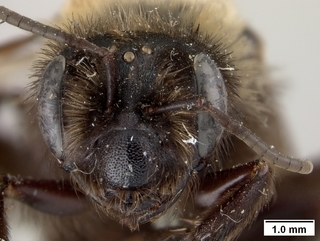
Smithsonian Institution, Entomology Department · 9
Andrena nivalis, female, face |
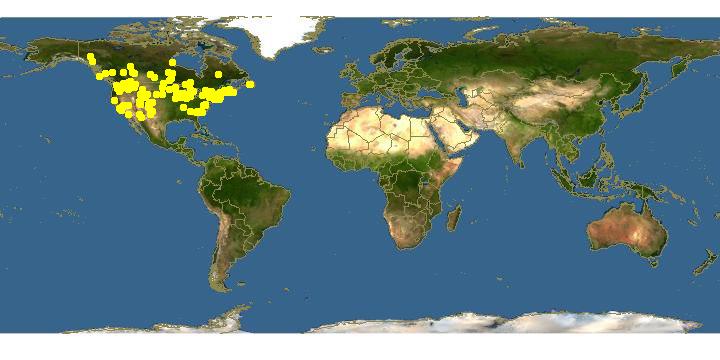
Click on map for details about points.
|
| Links | email Sam Droege sdroege@usgs.gov for a excel spreadsheet of ID information for the Eastern Melandrena males
- Hosts
|
80x5 -
240x3 -
240x4 -
320x1 -
320x2 -
320x3 -
640x1 -
640x2
Set display option above.
Click on
images to enlarge. |
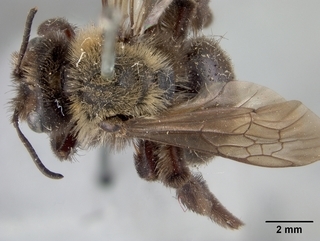
Smithsonian Institution, Entomology Department · 9
Andrena nivalis, female, top |
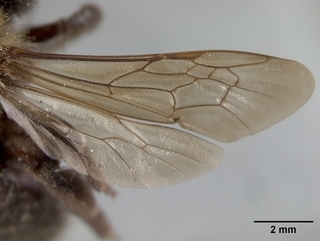
Smithsonian Institution, Entomology Department · 9
Andrena nivalis, female, wing |
|
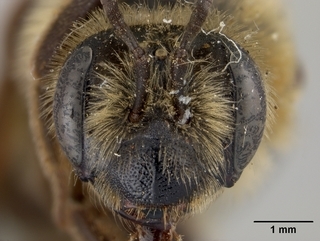
Smithsonian Institution, Entomology Department · 9
Andrena nivalis, female, face |
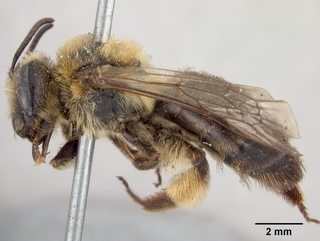
Smithsonian Institution, Entomology Department · 9
Andrena nivalis, female, side |
|
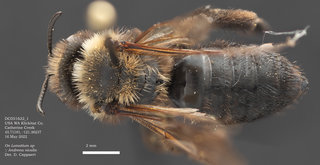
David Cappaert · 8
Andrena nivalis, female, dorsal, May |
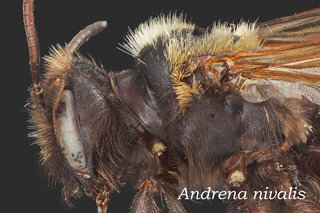
David Cappaert · 8
Andrena nivalis, thorax, dark light hairs, astragali |
|
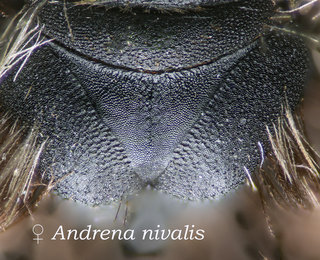
David Cappaert · 7
Andrena nivalis, thorax, propodeal triangle nivalis |
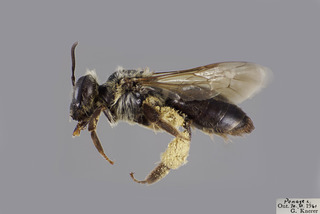
© Copyright Laurence Packer 2014
· 7
Andrena nivalis FEM CFP comp |
|
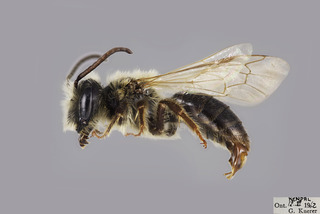
© Copyright Laurence Packer 2014
· 7
Andrena nivalis MALE CFP comp |
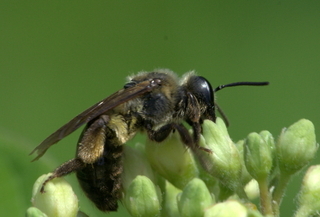
© Copyright Micheal Veit 2010
· 7
Andrena nivalis |
|
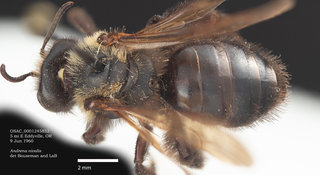
David Cappaert · 6
Andrena nivalis, female, dorsal, OSAC |
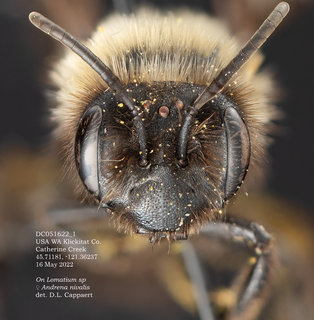
David Cappaert · 6
Andrena nivalis, female, head, May |
|
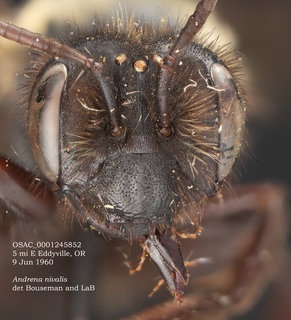
David Cappaert · 6
Andrena nivalis, female, head, OSAC |
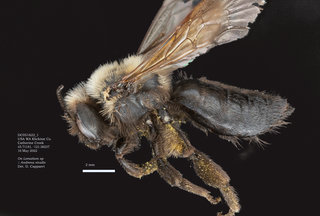
David Cappaert · 6
Andrena nivalis, female, lateral, May |
|
Overview |
Reprinted with permission of the American Entomological Society from:
Bouseman, J. K., LaBerge, W. E. 1978. A revision of the bees of the genus Andrena of the Western Hemisphere. Part IX. Subgenus Melandrena. Transactions of the American Entomological Society 104: 275-390.
Please report text errors to: leah at discoverlife dot org.
Andrena nivalis is a widespread, common, northern and western bee exhibiting an unusual amount of variability, especially in size and in vestiture color. This has led to a large number of synonyms for this bee. In Canada, except southern British Columbia, and in the United States east of the Rocky Mountains, nivalis is a uniformity pale bee with pale scopal hairs in the female. In California, except the northern tier of counties, nivalis is dark brown with pale thoracic hairs as in A. carlini. From northern California to southern British Columbia and east to Colorado and Wyoming, a mixture of pale and dark individuals occur with many intermediate forms. This clinal zone is too broad to justify the recognition of subspecies in the opinion of the present authors.
The female of nivalis can be separated from that of vicina by the lack of a median labral crista below the process, by the densely punctate scutellum and, at least in pale specimens, by the pale scopal hairs. The male of nivalis is readily distinguished by the notched tip of the eighth sternum (usually bidentate) and the propodeum being slightly less coarsely sculptured.
FEMALE. MEASUREMENTS AND RATIOS. — N = 20; length, 11-15 mm; width, 3-5 mm; wing length, M = 4.78 ± 0.205 mm; FL/FW, M = 0.99 ± 0.001; FOVL/FOVW, M = 2.88 ± 0.025.
INTEGUMENTAL COLOR. — Black except as follows: mandible with apical half and often entirely dark rufescent; flagellar segments 3-10 dark reddish-brown below; tegula rufescent, translucent; wing membranes moderately infumate, yellowish-brown, veins reddish-brown to brown; terga with apical areas usually slightly translucent, rufescent; sterna with narrow hyaline apical areas, basally often with rufescent reflections; distitarsi dark rufescent to black; tibial spurs testaceous.
STRUCTURE. — Antennal scape length as in vicina; flagellar segment 1 about as long as segments 2 plus 3; remaining segments as in vicina. Eyes each about four times as long as broad, inner margins converging slightly toward vertex. Malar space, galea and stipes as in vicina. Maxillary palpus as in vicina but segmental ratio about as 1.0:1.0:0.8:0.7:0.7:0.6. Labial palpus as in vicina but ratio about as 1.0:0.7:0.5:0.5. Labral process entire, usually trapezoidal, occasionally rounded, surface dulled by several transverse striations basally and irregular striations apically; labrum below process sulcate with several weak cristae but no strong median crista. Clypeus, supraclypeal area, and face above antennal fossae as in vicina. Facial fovea as in vicina but slightly broader above, separated from lateral ocellus usually by half an ocellar diameter or less. Vertex and genal area as in vicina.
Thoracic form and sculpturing as in vicina except as follows: scutellum densely punctate throughout, in least punctate areas punctures separated by half to one puncture width, moderately shiny to dull; propodeum outside of dorsal enclosure with punctures slightly smaller, surface not roughened. Wing venation, tibial spurs and claws as in vicina.
Metasomal terga sculptured much as in vicina. Pygidial plate V-shaped, apex not much rounded unless worn, without raised internal triangular area. Sterna as in vicina.
VESTITURE. — Pale specimens with vestiture pale ochraceous to ochraceous except as follows: vertex and dorsum of thorax occasionally dull fox-red; tergum 1 with white hairs; tergum 2 pale or pale with brown intermixed; tergum 4 usually entirely brown; tergum 5 and 6 dark brown; sternal hairs largely brown, long subapical hairs pale or pale in part; leg hairs brown on inner surfaces tarsi, often on inner surface hind tibia, on and surrounding basitibial plate, and on outer surfaces fore and middle tibiae in part. Dark specimens with dark brown to black hairs except as follows:
thoracic dorsum and posterior pronotal lobes ochraceous to dull fox-red. Specimens intermediate in vestitural color have more or less pale hairs on face, clypeus, vertex, propodeum, pleural areas and first few metasomal terga, and often have the scopal hairs of the hind tibia pale brown or ochraceous along posterior margin of tibia. Form and distribution of vestiture as in vicina.
MALE. MEASUREMENTS AND RATIOS. — N = 20; length, 9-12 mm; width, 2.0-3.5 mm; wing length, M = 4.08 ± 0.221 mm; FL/FW, M = 0.98 ± 0.005; FS1/FS2, M = 0.99 ± 0.011.
INTEGUMENTAL COLOR. — Black with same exceptions as female except as follows: mandible with apical third to half rufescent; wing membranes hyaline; terga with apical areas hyaline to translucent, yellow to rufescent, often with basal areas with rufescent reflections near apical areas.
STRUCTURE. — Antennal scape length usually equals first two and one-half flagellar segments; antennae otherwise as in vicina. Mandible, malar space and galea as in vicina. Maxillary palpus as in vicina but segmental ratio about as 1.0:1.0:0.9:0.9:0.8:0.9. Labial palpus as in vicina but ratio about as 1.0:0.7:0.5:0.6. Labrum, clypeus, supraclypeal area, face above antennal fossae, genal area and vertex as in vicina.
Thoracic form and sculpturing as in vicina except as follows: scutellum usually densely punctate throughout but often small mediolateral areas of sparse punctures present (smaller than in vicina); propodeum outside of dorsal enclosure tessellate and punctate but punctures small, not usually roughening surface. Wing venation, tibial spurs and claws as in vicina.
Metasomal terga sculptured as in vicina but punctures usually more distinct. Pygidial area and sterna 2-5 as in vicina. Sternum 6 as in vicina but usually shallowly and broadly emarginate apically.
Terminalia as in figures 79-83; note gonocoxite with dorsal lobe extremely short, sternum 8 with V-shaped emargination, and sternum 8 with apex bidentate.
vestiture. — Pale specimens with white to pale ochraceous hairs except as follows: terga 6 and 7 and often 5 usually with some brown hairs mixed with the white especially basally, occasionally entirely pale or mostly brown; sterna 6 and 8 with some hairs pale brown; outer surfaces tibiae often with hairs partly pale brown; inner surfaces tarsi yellow. Dark specimens with dark brown hairs except as follows; dorsum of thorax and posterior pronotal lobes pale ochraceous to dull fox-red. Intermediate forms have mixtures of pale and dark hairs or varying amounts of pale hair on vertex, face, pleural areas, propodeum, and first three or four metasomal terga. Form and distribution of hairs as in vicina but terga (especially 3 and 4) with basal area hairs often long and erect.
Reprinted with permission from: Mitchell, T.B. 1960. Bees of the Eastern United States. North Carolina Agricultural Experiment Station Technical Bulletin No. 141.
FEMALE. — Length 13 mm.; clypeus quite strongly convex, projecting nearly one-half below suborbital line, shining, with a narrow, rather indefinite, median, impunctate line, punctures on each side deep and distinct, rather fine and close; facial foveae broad above, occupying most of area between eyes and ocelli, covered with pale ochraceous tomentum; space between margin of vertex and lateral ocelli slightly greater than distance between ocelli; cheeks broader than eyes, rounded posteriorly, rather dull, minutely and rather closely punctured; length of malar space about one-third basal width of mandible; basal segment of flagellum subequal to 2nd and 3rd combined; process of labrum rather large, subtriangular, apex rather narrowly truncate; pubescence of head and thorax ochraceous, somewhat paler below; thoracic integument rather dull, scutum quite closely and finely punctate, punctures becoming obscure in center posteriorly, fine and close over most of scutellum; pleura more densely tessellate, punctures very fine and obscure, rather close; enclosure of propodeum dull, tessellate, rather coarsely rugoso-striate along basal margin; propodeal corbicula very short, without a distinct anterior fringe; trochanteral floccus imperfect; tibial scopa ochraceous, becoming more fuscous posteriorly, quite dense, hairs simple and rather elongate; fore and hind basitarsi slightly narrower than their respective tibiae, mid basitarsi about equal to their tibiae in width, front and middle tibiae and all tarsi clothed with fuscous pubescence; 2nd submarginal cell slightly shorter than 3rd, receiving 1st recurrent slightly beyond middle; abdominal terga somewhat shining, apical depressed areas distinct, occupying medially about one-third length of the discs, becoming reddish-hyaline toward rims, with a few very fine scattered punctures, remainder of discs finely but distinctly punctured, rather closely so toward sides, more sparsely in center, discal pubescence very short, suberect, largely pale, but with scattered, longer, more erect, fuscous hairs on 3rd and following terga, fasciae not developed, tergum 5 with a quite dense, apical, fuscous fimbria.
MALE. — Length 10 mm.; clypeus rather strongly convex, projecting nearly one-half below suborbital line, somewhat shining, punctures deep and distinct, well separated medially, becoming very close laterally, moderately coarse; space between margin of vertex and lateral ocelli slightly less than distance between ocelli; cheeks broader than eyes, rounded posteriorly (as in hilaris, fig. 21), rather dull, very minutely and obscurely punctate; length of malar space about one-fourth basal width of mandible; basal segment of flagellum slightly exceeding 2nd segment, about equal to 3rd; process of labrum rather large, subtriangular, apex rather broadly truncate; mandibles of moderate length, rather straight, with a distinct inner subapical tooth, overlapping about one-fourth; pubescence over entire head, thorax and legs whitish, becoming slightly yellowish only on the fore and mid tibiae; thoracic integument rather dull and tessellate, punctures of scutum rather shallow but quite distinct, rather close anteriorly, becoming sparse in center posteriorly, those on scutellum fine and distinct, well separated but hardly sparse; pleura more densely tessellate, punctures fine and obscure; enclosure of propodeum dull and tessellate, very narrowly substriate along basal margin; all basitarsi slender and elongate, considerably narrower than their respective tibiae; 2nd submarginal cell slightly shorter than 3rd, receiving 1st recurrent slightly beyond middle; abdominal terga rather smooth, apical depressed areas quite distinct, rather broadly hyaline along rims, nearly impunctate, remaining portions of discs very finely but distinctly punctate, punctures well separated but not sparse laterally, becoming more sparse medially, discal pubescence very short, suberect, whitish, fasciae not developed; apical portion of sternum 8 slender medially, with a rather pronounced submedian ventral protuberance, quite densely pubescent from this to near the apex which is rounded but deeply incised medially; penis valves very gradually and slightly enlarged basally, not excavated, gonocoxites very long and slender, scarcely at all dilated, gonocoxal lobes not produced.
DISTRIBUTION. — Alberta to Quebec in Canada, and Minnesota to the New England states, south to North Carolina and Georgia; April to July.
FLOWER RECORDS. — Hydrangea, Rhododendron, Rubus and Vagnera.
It has been assumed that convexa Provancher is a synonym of nivalis, but as the writer was unable to locate the type of nivalis at the British Museum, or in the Hope Museum at Oxford, no opinion concerning the validity of this assumption can be expressed here. The types of semirufa Cockerell (F) and of convexa (M) have been studied and there seems little doubt that they belong together. Cockerell (1901) recognized the marked similarity of semirufa and nivalis and suggested the possibility that they are the same.
|
|
|
Identification |
Extracted from North-American Bees, and a new homopteron by Cockerell (1903).
.-Like that of A. carlini, but more robust; first j oint
of flagellum some ..... hat longer; abdomen with a good deal
of black hair, especially beneath; hair on inner side of
tibire and tarsi sooty with a sort of purplish tint; second
submarginal cell mueh larger.
lJab. Placita, N. :M., Apri l 25, 1903, both sexes at flowers
of wild plum (W. P. &; '1'. D. A. Cockerell).
New to New Ml:xieo. Also found at P!acita Oil the same
day were Andrena erythrogaster(Ashmead), common at flowers of Salix. new to New Mexico j A . Cressonii, Rob.
(the form kansensis) ; and Haliclus perdifficilis, Ckll.
|
|
|
Names | |
|
|
| Supported by | |
Updated: 2024-04-20 03:35:58 gmt
|